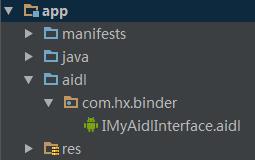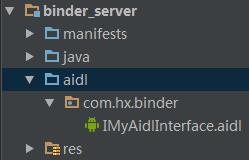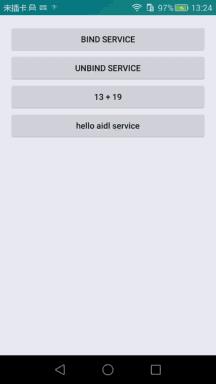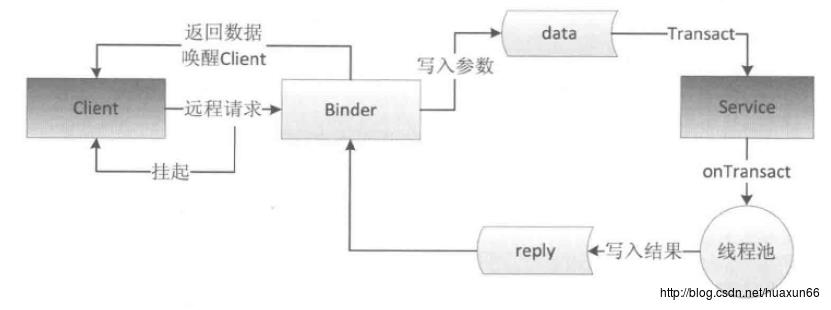Android Binder机制完全解析
Posted huaxun66
tags:
篇首语:本文由小常识网(cha138.com)小编为大家整理,主要介绍了Android Binder机制完全解析相关的知识,希望对你有一定的参考价值。
概述
之前我写过一篇文章Android Service全面解析,简单实现了如何通过AIDL实现Service的跨进程通信(IPC),其实是通过Binder机制来实现的,本文我们就重点来看看Binder机制的原理。
Binder可以提供系统中任何程序都可以访问的全局服务。这个功能当然是任何系统都应该提供的,下面我们简单看一下android的Binder的框架:
Android Binder框架分为服务器接口、Binder驱动、以及客户端接口;简单想一下,需要提供一个全局服务,那么全局服务那端即是服务器接口,任何程序即客户端接口,它们之间通过一个Binder驱动访问。
- 服务器接口:实际上是Binder类的对象,该对象一旦创建,内部则会启动一个隐藏线程,接收Binder驱动发送的消息,收到消息后,会执行Binder对象中的onTransact()函数,并按照该函数的参数执行不同的服务器端代码。
- Binder驱动:该对象也为Binder类的实例,客户端通过该对象访问远程服务。
- 客户端接口:获得Binder驱动,调用其transact()发送消息至服务器。
实例实现
如果你觉得上面的描述太抽象了,没关系,下面我们通过一个具体的例子来看看Binder机制的原理。例子我仍然使用上一篇文章的例子,不过之前我是使用Eclipse创建工程,今天我们使用Studio来创建项目,效果都是一样的。
(1)Studio创建两个Module,app代表客户端程序,binder_server代表服务器端程序。

(2)创建aidl文件
在app目录上右键,NEW->AIDL->AIDL File,创建一个aidl文件(IMyAidlInterface.aidl),同时必须要指明包名,包名必须和java目录下的包名一致。此aidl文件会默认生成到aidl目录下,aidl目录和java目录同级别。

IMyAidlInterface.aidl文件内容:
interface IMyAidlInterface {
int plus(int a, int b);
String toUpperCase(String str);
}build一下,会自动生成IMyAidlInterface.java文件,不同于Eclipse的gen目录,studio下的java文件目录为:
*(项目名)\\app\\build\\generated\\source\\aidl\\debug\\com\\hx\\binder\\IMyAidlInterface.java
关于IMyAidlInterface.java文件内容,我们后面会具体分析,这里先省略。
(3)将aidl文件连同目录一起拷贝到服务器端

(4)服务器端新建服务MyRemoteService
public class MyRemoteService extends Service {
@Override
public void onCreate() {
super.onCreate();
MainActivity.showlog("onCreate()");
}
@Override
public int onStartCommand(Intent intent, int flags, int startId) {
MainActivity.showlog("onStartCommand()");
return super.onStartCommand(intent, flags, startId);
}
@Override
public void onDestroy() {
super.onDestroy();
MainActivity.showlog("onDestroy()");
}
@Override
public IBinder onBind(Intent intent) {
MainActivity.showlog("onBind()");
return mBinder;
}
@Override
public boolean onUnbind(Intent intent) {
MainActivity.showlog("onUnbind()");
return super.onUnbind(intent);
}
IMyAidlInterface.Stub mBinder = new IMyAidlInterface.Stub() {
@Override
public String toUpperCase(String str) throws RemoteException {
if (str != null) {
return str.toUpperCase();
}
return null;
}
@Override
public int plus(int a, int b) throws RemoteException {
return a + b;
}
};
}在Manifest中进行注册:
<service android:name=".MyRemoteService"
android:exported="true">
<intent-filter>
<action android:name="com.hx.action.remoteService" />
</intent-filter>
</service>(4)编写客户端代码
public class MainActivity extends Activity implements View.OnClickListener {
private Button bindService;
private Button unbindService;
private Button plus;
private Button toUpperCase;
private IMyAidlInterface myAIDLInterface;
private ServiceConnection connection = new ServiceConnection() {
@Override
public void onServiceDisconnected(ComponentName name) {
myAIDLInterface = null;
Toast.makeText(MainActivity.this, "onServiceDisconnected", Toast.LENGTH_SHORT).show();
}
@Override
public void onServiceConnected(ComponentName name, IBinder service) {
myAIDLInterface = IMyAidlInterface.Stub.asInterface(service);
Toast.makeText(MainActivity.this, "onServiceConnected", Toast.LENGTH_SHORT).show();
}
};
@Override
protected void onCreate(Bundle savedInstanceState) {
super.onCreate(savedInstanceState);
setContentView(R.layout.activity_main);
bindService = (Button) findViewById(R.id.bind_service);
unbindService = (Button) findViewById(R.id.unbind_service);
plus = (Button) findViewById(R.id.plus);
toUpperCase = (Button) findViewById(R.id.toUpperCase);
//button点击事件
bindService.setOnClickListener(this);
unbindService.setOnClickListener(this);
plus.setOnClickListener(this);
toUpperCase.setOnClickListener(this);
}
@Override
public void onClick(View v) {
switch (v.getId()) {
case R.id.bind_service:
Intent intent = new Intent("com.hx.action.remoteService");
//5.0以上安卓设备,service intent必须为显式指出
Intent eintent = new Intent(getExplicitIntent(this,intent));
bindService(eintent, connection, Context.BIND_AUTO_CREATE);
// bindService(intent, connection, BIND_AUTO_CREATE);
break;
case R.id.unbind_service:
if(myAIDLInterface != null){
unbindService(connection);
}
break;
case R.id.plus:
if (myAIDLInterface != null) {
try {
int result = myAIDLInterface.plus(13, 19);
Toast.makeText(this, result + "", Toast.LENGTH_SHORT).show();
} catch (RemoteException e) {
e.printStackTrace();
}
} else {
Toast.makeText(this, "服务器被异常杀死,请重新绑定服务端", Toast.LENGTH_SHORT).show();
}
break;
case R.id.toUpperCase:
if (myAIDLInterface != null) {
try {
String upperStr = myAIDLInterface.toUpperCase("hello aidl service");
Toast.makeText(this, upperStr + "", Toast.LENGTH_SHORT).show();
} catch (RemoteException e) {
e.printStackTrace();
}
} else {
Toast.makeText(this, "服务器被异常杀死,请重新绑定服务端", Toast.LENGTH_SHORT).show();
}
break;
default:
break;
}
}
public static Intent getExplicitIntent(Context context, Intent implicitIntent) {
// Retrieve all services that can match the given intent
PackageManager pm = context.getPackageManager();
List<ResolveInfo> resolveInfo = pm.queryIntentServices(implicitIntent, 0);
// Make sure only one match was found
if (resolveInfo == null || resolveInfo.size() != 1) {
return null;
}
// Get component info and create ComponentName
ResolveInfo serviceInfo = resolveInfo.get(0);
String packageName = serviceInfo.serviceInfo.packageName;
String className = serviceInfo.serviceInfo.name;
ComponentName component = new ComponentName(packageName, className);
// Create a new intent. Use the old one for extras and such reuse
Intent explicitIntent = new Intent(implicitIntent);
// Set the component to be explicit
explicitIntent.setComponent(component);
return explicitIntent;
}
}<?xml version="1.0" encoding="utf-8"?>
<LinearLayout xmlns:android="http://schemas.android.com/apk/res/android"
android:id="@+id/activity_main"
android:layout_width="match_parent"
android:layout_height="match_parent"
android:paddingBottom="@dimen/activity_vertical_margin"
android:paddingLeft="@dimen/activity_horizontal_margin"
android:paddingRight="@dimen/activity_horizontal_margin"
android:paddingTop="@dimen/activity_vertical_margin"
android:orientation="vertical">
<Button
android:id="@+id/bind_service"
android:layout_width="match_parent"
android:layout_height="wrap_content"
android:text="bind service" />
<Button
android:id="@+id/unbind_service"
android:layout_width="match_parent"
android:layout_height="wrap_content"
android:text="unbind service" />
<Button
android:id="@+id/plus"
android:layout_width="match_parent"
android:layout_height="wrap_content"
android:text="13 + 19" />
<Button
android:id="@+id/toUpperCase"
android:layout_width="match_parent"
android:layout_height="wrap_content"
android:textAllCaps="false"
android:text="hello aidl service" />
</LinearLayout>运行程序,看效果:

我们首先点击BIND SERVICE按钮,绑定服务,会弹出“onServiceConnected”的Toast,说明服务绑定成功,获取到了服务器端的Binder驱动。
服务端Log:

然后分别点击13+19和hello aidl service按钮,可以通过Binder驱动调用服务端的代码并返回正确的计算结果。
最后点击UNBIND SERVICE按钮,我们的期望是弹出“onServiceDisconnected”的Toast,解除绑定,实际上呢?很遗憾没有弹出。
服务端Log:

由于我们当前只有一个客户端绑定了此Service,所以Service调用了onUnbind和onDestory。当我们继续点击13+19按钮,发现依然可以正确执行得到结果,也就是说即使onUnbind被调用,连接也是不会断开的,那么什么时候会断开连接呢?
即当服务端被异常终止的时候,比如我们现在在手机的正在执行的程序中找到该服务,并强行停止它:

可以看到这时弹出了“onServiceDisconnected”的Toast,说明连接被断开。之后再次点击13+19按钮,则会弹出Toast提示“服务器被异常杀死,请重新绑定服务端”。
原理分析
还记得我们上面根据aidl文件生成的Java文件吗?我们来看看它的结构吧:
public interface IMyAidlInterface extends android.os.IInterface {
/**
* Local-side IPC implementation stub class.
*/
public static abstract class Stub extends android.os.Binder implements com.hx.binder.IMyAidlInterface {
private static final java.lang.String DESCRIPTOR = "com.hx.binder.IMyAidlInterface";
/**
* Construct the stub at attach it to the interface.
*/
public Stub() {
this.attachInterface(this, DESCRIPTOR);
}
/**
* Cast an IBinder object into an com.hx.binder.IMyAidlInterface interface,
* generating a proxy if needed.
*/
public static com.hx.binder.IMyAidlInterface asInterface(android.os.IBinder obj) {
if ((obj == null)) {
return null;
}
android.os.IInterface iin = obj.queryLocalInterface(DESCRIPTOR);
if (((iin != null) && (iin instanceof com.hx.binder.IMyAidlInterface))) {
return ((com.hx.binder.IMyAidlInterface) iin);
}
return new com.hx.binder.IMyAidlInterface.Stub.Proxy(obj);
}
@Override
public android.os.IBinder asBinder() {
return this;
}
@Override
public boolean onTransact(int code, android.os.Parcel data, android.os.Parcel reply, int flags) throws android.os.RemoteException {
switch (code) {
case INTERFACE_TRANSACTION: {
reply.writeString(DESCRIPTOR);
return true;
}
case TRANSACTION_plus: {
data.enforceInterface(DESCRIPTOR);
int _arg0;
_arg0 = data.readInt();
int _arg1;
_arg1 = data.readInt();
int _result = this.plus(_arg0, _arg1);
reply.writeNoException();
reply.writeInt(_result);
return true;
}
case TRANSACTION_toUpperCase: {
data.enforceInterface(DESCRIPTOR);
java.lang.String _arg0;
_arg0 = data.readString();
java.lang.String _result = this.toUpperCase(_arg0);
reply.writeNoException();
reply.writeString(_result);
return true;
}
}
return super.onTransact(code, data, reply, flags);
}
private static class Proxy implements com.hx.binder.IMyAidlInterface {
private android.os.IBinder mRemote;
Proxy(android.os.IBinder remote) {
mRemote = remote;
}
@Override
public android.os.IBinder asBinder() {
return mRemote;
}
public java.lang.String getInterfaceDescriptor() {
return DESCRIPTOR;
}
@Override
public int plus(int a, int b) throws android.os.RemoteException {
android.os.Parcel _data = android.os.Parcel.obtain();
android.os.Parcel _reply = android.os.Parcel.obtain();
int _result;
try {
_data.writeInterfaceToken(DESCRIPTOR);
_data.writeInt(a);
_data.writeInt(b);
mRemote.transact(Stub.TRANSACTION_plus, _data, _reply, 0);
_reply.readException();
_result = _reply.readInt();
} finally {
_reply.recycle();
_data.recycle();
}
return _result;
}
@Override
public java.lang.String toUpperCase(java.lang.String str) throws android.os.RemoteException {
android.os.Parcel _data = android.os.Parcel.obtain();
android.os.Parcel _reply = android.os.Parcel.obtain();
java.lang.String _result;
try {
_data.writeInterfaceToken(DESCRIPTOR);
_data.writeString(str);
mRemote.transact(Stub.TRANSACTION_toUpperCase, _data, _reply, 0);
_reply.readException();
_result = _reply.readString();
} finally {
_reply.recycle();
_data.recycle();
}
return _result;
}
}
static final int TRANSACTION_plus = (android.os.IBinder.FIRST_CALL_TRANSACTION + 0);
static final int TRANSACTION_toUpperCase = (android.os.IBinder.FIRST_CALL_TRANSACTION + 1);
}
public int plus(int a, int b) throws android.os.RemoteException;
public java.lang.String toUpperCase(java.lang.String str) throws android.os.RemoteException;
}代码比较长,但思路还是比较清晰的,IMyAidlInterface.java文件包含两个静态内部类—Stub和Proxy(其中Proxy是Stub的内部类)。
public static abstract class Stub extends android.os.Binder implements com.hx.binder.IMyAidlInterface其中Stub是个抽象类,它继承了Binder,并实现了IMyAidlInterface接口。Stub提供了几个方法:asInterface、asBinder、onTransact,但并没有实现IMyAidlInterface接口的方法,所以需要交给Stub的实现类去实现。
private static class Proxy implements com.hx.binder.IMyAidlInterfaceProxy是Stub的内部类,也实现了IMyAidlInterface接口。并提供了几个方法:asBinder、getInterfaceDescriptor,并实现了IMyAidlInterface接口的方法plus和toUpperCase。
接下来看看服务端和客户端是如何和这个文件建立关联的吧。
服务端:
IMyAidlInterface.Stub mBinder = new IMyAidlInterface.Stub() {
@Override
public String toUpperCase(String str) throws RemoteException {
if (str != null) {
return str.toUpperCase();
}
return null;
}
@Override
public int plus(int a, int b) throws RemoteException {
return a + b;
}
};可以看到我们服务端提供的服务是由IMyAidlInterface.Stub来执行的,上面分析过,Stub这个类是Binder的子类,是不是符合我们文章开头所说的服务端其实是一个Binder类的实例。而且mBinder实现了IMyAidlInterface接口的方法。
接下来看Stub的onTransact()方法:
public boolean onTransact(int code, android.os.Parcel data, android.os.Parcel reply, int flags) throws android.os.RemoteException {
switch (code) {
case INTERFACE_TRANSACTION: {
reply.writeString(DESCRIPTOR);
return true;
}
case TRANSACTION_plus: {
data.enforceInterface(DESCRIPTOR);
int _arg0;
_arg0 = data.readInt();
int _arg1;
_arg1 = data.readInt();
int _result = this.plus(_arg0, _arg1);
reply.writeNoException();
reply.writeInt(_result);
return true;
}
case TRANSACTION_toUpperCase: {
data.enforceInterface(DESCRIPTOR);
java.lang.String _arg0;
_arg0 = data.readString();
java.lang.String _result = this.toUpperCase(_arg0);
reply.writeNoException();
reply.writeString(_result);
return true;
}
}
return super.onTransact(code, data, reply, flags);
}文章开头也说到服务端的Binder实例会根据客户端依靠Binder驱动发来的消息,执行onTransact方法,然后由其参数决定执行服务端的代码。
可以看到onTransact有四个参数:code , data ,replay , flags
- code:是一个整形的唯一标识,用于区分执行哪个方法,客户端会传递此参数,告诉服务端执行哪个方法
- data:客户端传递过来的参数
- reply:服务器返回回去的值
- flags:标明是否有返回值,0为有(双向),1为没有(单向)
我们仔细看case TRANSACTION_plus中的代码:
data.enforceInterface(DESCRIPTOR); 与客户端的writeInterfaceToken对应,标识远程服务的名称
int _arg0;
_arg0 = data.readInt();
int _arg1;
_arg1 = data.readInt();接下来分别读取了客户端传入的两个参数
int _result = this.plus(_arg0, _arg1);
reply.writeNoException();
reply.writeInt(_result);然后执行this.plus,即我们服务端实现的plus方法;返回result由reply写回。
toUpperCase同理,可以看到服务端通过AIDL生成的Stub类,封装了服务端本来需要写的代码。
客户端
客户端主要通过ServiceConnected与服务端连接
private ServiceConnection connection = new ServiceConnection() {
@Override
public void onServiceDisconnected(ComponentName name) {
isConnected = false;
Toast.makeText(MainActivity.this, "onServiceDisconnected", Toast.LENGTH_SHORT).show();
}
@Override
public void onServiceConnected(ComponentName name, IBinder service) {
isConnected = true;
myAIDLInterface = IMyAidlInterface.Stub.asInterface(service);
Toast.makeText(MainActivity.this, "onServiceConnected", Toast.LENGTH_SHORT).show();
}
};其实这个onServiceConnected中的IBinder实例,其实就是我们文章开头所说的Binder驱动,也是一个Binder实例。
在IMyAidlInterface.Stub.asInterface中最终调用了:
return new com.hx.binder.IMyAidlInterface.Stub.Proxy(obj);这个Proxy实例传入了我们的Binder驱动,并且封装了我们调用服务端的代码,文章开头说,客户端会通过Binder驱动的transact()方法调用服务端代码。
直接看Proxy中的plus方法
public int plus(int a, int b) throws android.os.RemoteException {
android.os.Parcel _data = android.os.Parcel.obtain();
android.os.Parcel _reply = android.os.Parcel.obtain();
int _result;
try {
_data.writeInterfaceToken(DESCRIPTOR);
_data.writeInt(a);
_data.writeInt(b);
mRemote.transact(Stub.TRANSACTION_plus, _data, _reply, 0);
_reply.readException();
_result = _reply.readInt();
} finally {
_reply.recycle();
_data.recycle();
}
return _result;
}首先声明两个Parcel对象,一个用于传递数据,一个用户接收返回的数据
_data.writeInterfaceToken(DESCRIPTOR);与服务器端的enforceInterfac对应
_data.writeInt(a);
_data.writeInt(b);写入需要传递的参数
mRemote.transact(Stub.TRANSACTION_plus, _data, _reply, 0);终于看到了我们的transact方法,第一个对应服务端的code,_data,_reply分别对应服务端的data,reply,0表示是双向的
_reply.readException();
_result = _reply.readInt();最后读出我们服务端返回的数据,然后return。可以看到和服务端的onTransact基本是一行一行对应的。
注意:
- 当客户端调用transact方法发起RPC(远程过程调用)请求后,当前线程会挂起,等待服务器端的返回结果。所以如果一个远程方法很耗时,那么不能再UI线程中调用此远程方法。
- 服务端的Binder方法(onTransact)运行在Binder线程池中,所以Binder方法不管是否耗时,都应该采取同步机制,因为它已经运行在一个线程中了。
到此,我们已经通过AIDL生成的代码解释了Android Binder框架的工作原理。Service的作用其实就是为我们创建Binder驱动,即服务端与客户端连接的桥梁。
AIDL其实通过我们写的aidl文件,帮助我们生成了一个接口,一个Stub类用于服务端,一个Proxy类用于客户端调用。

不依赖AIDL实现IPC通信
那么我们是否可以不通过写aidl文件来实现远程的通信呢?下面向大家展示如何完全不依赖AIDL来实现客户端与服务端的通信。
服务端代码:
public class MyRemoteService extends Service {
private static final String DESCRIPTOR = "MyRemoteService";
private static final int TRANSACTION_plus = 0x110;
private static final int TRANSACTION_toUpperCase = 0x111;
@Override
public void onCreate() {
super.onCreate();
MainActivity.showlog("onCreate()");
}
@Override
public int onStartCommand(Intent intent, int flags, int startId) {
MainActivity.showlog("onStartCommand()");
return super.onStartCommand(intent, flags, startId);
}
@Override
public void onDestroy() {
super.onDestroy();
MainActivity.showlog("onDestroy()");
}
@Override
public IBinder onBind(Intent intent) {
MainActivity.showlog("onBind()");
return mBinder;
}
@Override
public boolean onUnbind(Intent intent) {
MainActivity.showlog("onUnbind()");
return super.onUnbind(intent);
}
private MyBinder mBinder = new MyBinder();
private class MyBinder extends Binder {
@Override
public boolean onTransact(int code, android.os.Parcel data, android.os.Parcel reply, int flags) throws android.os.RemoteException {
switch (code) {
case INTERFACE_TRANSACTION: {
reply.writeString(DESCRIPTOR);
return true;
}
case TRANSACTION_plus: {
data.enforceInterface(DESCRIPTOR);
int _arg0;
_arg0 = data.readInt();
int _arg1;
_arg1 = data.readInt();
int _result = _arg0 + _arg1;
reply.writeNoException();
reply.writeInt(_result);
return true;
}
case TRANSACTION_toUpperCase: {
data.enforceInterface(DESCRIPTOR);
java.lang.String _arg0;
_arg0 = data.readString();
java.lang.String _result = _arg0.toUpperCase();
reply.writeNoException();
reply.writeString(_result);
return true;
}
}
return super.onTransact(code, data, reply, flags);
}
};
}<service android:name=".MyRemoteService"
android:exported="true">
<intent-filter>
<action android:name="com.hx.action.remoteService" />
</intent-filter>
</service>客户端代码:
public class MainActivity extends Activity implements View.OnClickListener {
private Button bindService;
private Button unbindService;
private Button plus;
private Button toUpperCase;
private IBinder myBinder;
private static final String DESCRIPTOR = "MyRemoteService";
private static final int TRANSACTION_plus = 0x110;
private static final int TRANSACTION_toUpperCase = 0x111;
private ServiceConnection connection = new ServiceConnection() {
@Override
public void onServiceDisconnected(ComponentName name) {
myBinder = null;
Toast.makeText(MainActivity.this, "onServiceDisconnected", Toast.LENGTH_SHORT).show();
}
@Override
public void onServiceConnected(ComponentName name, IBinder service) {
myBinder = service;
Toast.makeText(MainActivity.this, "onServiceConnected", Toast.LENGTH_SHORT).show();
}
};
@Override
protected void onCreate(Bundle savedInstanceState) {
super.onCreate(savedInstanceState);
setContentView(R.layout.activity_main);
bindService = (Button) findViewById(R.id.bind_service);
unbindService = (Button) findViewById(R.id.unbind_service);
plus = (Button) findViewById(R.id.plus);
toUpperCase = (Button) findViewById(R.id.toUpperCase);
//button点击事件
bindService.setOnClickListener(this);
unbindService.setOnClickListener(this);
plus.setOnClickListener(this);
toUpperCase.setOnClickListener(this);
}
@Override
public void onClick(View v) {
switch (v.getId()) {
case R.id.bind_service:
Intent intent = new Intent("com.hx.action.remoteService");
//5.0以上安卓设备,service intent必须为显式指出
Intent eintent = new Intent(getExplicitIntent(this,intent));
bindService(eintent, connection, Context.BIND_AUTO_CREATE);
// bindService(intent, connection, BIND_AUTO_CREATE);
break;
case R.id.unbind_service:
if(myBinder != null){
unbindService(connection);
}
break;
case R.id.plus:
if (myBinder != null) {
android.os.Parcel _data = android.os.Parcel.obtain();
android.os.Parcel _reply = android.os.Parcel.obtain();
int _result;
try {
_data.writeInterfaceToken(DESCRIPTOR);
_data.writeInt(78);
_data.writeInt(95);
myBinder.transact(TRANSACTION_plus, _data, _reply, 0);
_reply.readException();
_result = _reply.readInt();
Toast.makeText(this, _result + "", Toast.LENGTH_SHORT).show();
} catch (RemoteException e) {
e.printStackTrace();
} finally {
_reply.recycle();
_data.recycle();
}
} else {
Toast.makeText(this, "服务器被异常杀死,请重新绑定服务端", Toast.LENGTH_SHORT).show();
}
break;
case R.id.toUpperCase:
if (myBinder != null) {
android.os.Parcel _data = android.os.Parcel.obtain();
android.os.Parcel _reply = android.os.Parcel.obtain();
java.lang.String _result;
try {
_data.writeInterfaceToken(DESCRIPTOR);
_data.writeString("my new programe");
myBinder.transact(TRANSACTION_toUpperCase, _data, _reply, 0);
_reply.readException();
_result = _reply.readString();
Toast.makeText(this, _result + "", Toast.LENGTH_SHORT).show();
} catch (RemoteException e) {
e.printStackTrace();
} finally {
_reply.recycle();
_data.recycle();
}
} else {
Toast.makeText(this, "服务器被异常杀死,请重新绑定服务端", Toast.LENGTH_SHORT).show();
}
break;
default:
break;
}
}
public static Intent getExplicitIntent(Context context, Intent implicitIntent) {
// Retrieve all services that can match the given intent
PackageManager pm = context.getPackageManager();
List<ResolveInfo> resolveInfo = pm.queryIntentServices(implicitIntent, 0);
// Make sure only one match was found
if (resolveInfo == null || resolveInfo.size() != 1) {
return null;
}
// Get component info and create ComponentName
ResolveInfo serviceInfo = resolveInfo.get(0);
String packageName = serviceInfo.serviceInfo.packageName;
String className = serviceInfo.serviceInfo.name;
ComponentName component = new ComponentName(packageName, className);
// Create a new intent. Use the old one for extras and such reuse
Intent explicitIntent = new Intent(implicitIntent);
// Set the component to be explicit
explicitIntent.setComponent(component);
return explicitIntent;
}
}<?xml version="1.0" encoding="utf-8"?>
<LinearLayout xmlns:android="http://schemas.android.com/apk/res/android"
android:id="@+id/activity_main"
android:layout_width="match_parent"
android:layout_height="match_parent"
android:paddingBottom="@dimen/activity_vertical_margin"
android:paddingLeft="@dimen/activity_horizontal_margin"
android:paddingRight="@dimen/activity_horizontal_margin"
android:paddingTop="@dimen/activity_vertical_margin"
android:orientation="vertical">
<Button
android:id="@+id/bind_service"
android:layout_width="match_parent"
android:layout_height="wrap_content"
android:text="bind service" />
<Button
android:id="@+id/unbind_service"
android:layout_width="match_parent"
以上是关于Android Binder机制完全解析的主要内容,如果未能解决你的问题,请参考以下文章